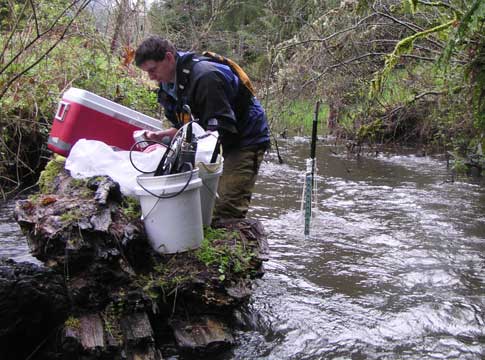The McKenzie River is the sole source of drinking water for nearly 200,000 people in the Eugene metropolitan area. Wildfires can have potential impacts on our community's drinking water from source to tap.

The McKenzie Watershed is comprised of 88% forested land, with a mixture of private, state, and federally owned lands. Forested watersheds, like the McKenzie, produce better water quality than any other surface water source. But our watershed is susceptible to threats related to development, forestry practices, agricultural activities, urban runoff, hazardous materials transportation, and wildfire.
Forest fires can be beneficial to overall forest health. However, severe forest fires can have impacts on downstream water quality conditions. Fire-related compounds such as organic carbon, nutrients, metals, various chemical contaminants along with increased sediment from burned and eroded slopes can enter the river post-fire during rainfall events. Increased nutrients can impact downstream biological processes, such as increased algal growth.
It is anticipated that climate change impacts in the McKenzie will show up as extreme weather events resulting in increased wildfires.
We take these threats to the McKenzie River seriously. For more than 20 years, our Drinking Water Source Protection Program has helped create a balance between watershed health and human use over time to maintain and even improve our community's exceptional water quality.
Monitoring Water Quality
In response to a wlidfire event, EWEB increases monitoring of raw and treated water for pollutants related to fire impacts to ensure we identify any potential issues before they become a problem. For the most recent enhanced monitoring summaries, check out our Water Quality Reports page. We employ two different types of instruments in the watershed and at the Hayden Bridge Filtration Plant intake to monitor dissolved carbon levels in real time. This provides an early warning system to allow operators to prepare for and adjust treatment strategies prior to the river water entering the filtration plant.
Water Treatment
Wildfires in the McKenzie River Valley can cause an increase in organic material coming from the burned and eroded landscape above and around the river, particularly following a heavy rain. The organic material is made up of ash and particles from burned vegetation and soil. Some portion of the organic material also dissolves into the river water and is called dissolved organic carbon. The filtration plant treats and filters organic material, including dissolved organic carbon, using the powdered active carbon (PAC) and rapid sand filtration systems. The PAC system works by adsorbing (attracting like a magnet) these organic material compounds to the carbon molecules. Once adsorbed to the PAC, the compounds are removed by the filtration process.
Heavy rain events also increase turbidity (suspended particles including soil), which is also effectively treated using PAC and rapid sand filtration.
In response to wildfire or other significant watershed event, EWEB staff will continue to monitor both the source water and treated drinking water and adjust the overall treatment process on an ongoing basis. If any of this heightened monitoring shows any breakthrough of contaminants from the PAC system or filtration process at levels of public health concern, EWEB will notify our customers as soon as possible.
Public health is our top priority as we strive to meet the expectations for reliable service to our community's homes and businesses.

